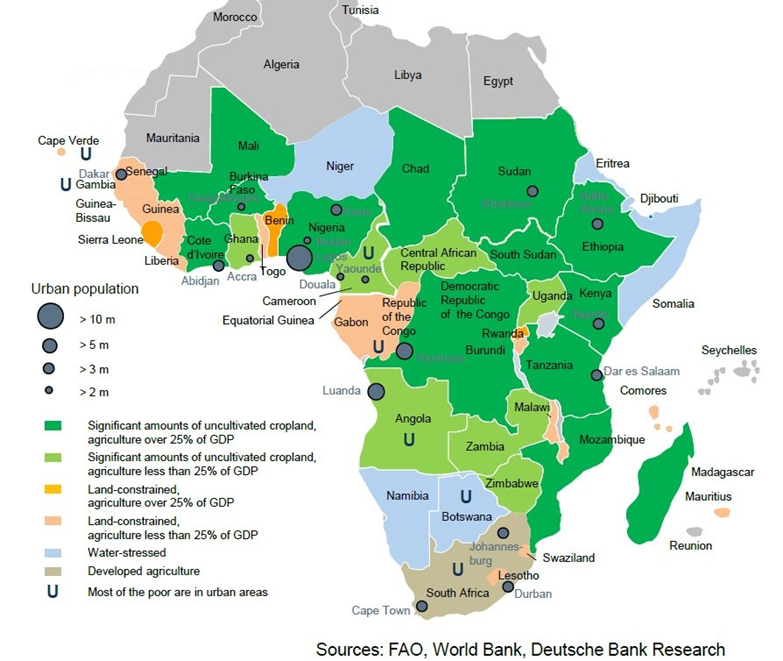The continent is characterized by persistent food insecurity. A non-exhaustive list includes the 1967–1970 Biafra famine (Nigeria), the 1983–1985 Lesotho crisis, the 1972–1974 and 1984–1985 Ethiopian famines, the 2004 Darfur crisis (Sudan), the 2005 Niger famine, and the 2011–2012 Horn of Africa drought. As of 2016, food insecurity remains prevalent in the Democratic Republic of Congo (DRC), Ethiopia, Malawi, and other regions.
The two primary causes are climatic events and conflicts. For instance, droughts frequently afflict the Horn of Africa, while conflicts drive food insecurity in the DRC. In some cases, climatic events themselves exacerbate tensions, as seen in Darfur, where competition over dwindling resources fueled violence.
Although North Africa is relatively spared, and the prevalence of undernourishment has declined (from 27.6% in 1990–1992 to 20% in 2014–2016), population growth has led to an increase in the absolute number of affected individuals—from 182 million to 233 million during the same period. Globally, however, both prevalence and absolute numbers of undernourishment have decreased.
In this context, African agriculture has become a central concern for economists and policymakers. Enhancing its climate resilience and efficiency could reduce political instability, improve public health, and generate millions of jobs. Given unparalleled population growth, a rural populace that constitutes 60% of the total population (and continues to grow in absolute terms), and an agricultural sector providing 65% of sub-Saharan Africa’s employment, the sector is widely regarded as pivotal to the continent’s development.
African agriculture has tripled in value since the 1980s, primarily through expanding croplands into forests and savannahs. As noted, “Over the last three decades, agricultural productivity gains in Africa have been achieved largely by expanding rainfed crops, particularly food crops, onto increasingly marginal lands and/or shortening traditional fallow periods.” This expansion poses significant environmental challenges, including soil degradation. The sector remains characterized by low productivity, minimal input use (fertilizers, etc.), limited irrigation and mechanization, and smallholder dominance.
Alongside subsistence farming, cash crops and export-oriented agriculture (coffee, cocoa, peanuts, cotton) thrive on larger, more productive farms. In 2006, agricultural products accounted for 20% of Africa’s international trade volume and 30% of its export value.
The most urbanized nations exhibit higher agricultural value-added and producer prices, as dense urban markets create solvent demand for surplus sales. Conversely, poverty and food insecurity disproportionately affect rural populations in agrarian economies. Poor farmers in these regions struggle to monetize their production, trapped in informal exchange systems that limit access to productivity-boosting inputs.
Contrary to popular belief, Africa does not face an overall food shortage. Even rural smallholders have seen improved food availability. The 2008 “food riots” across the continent (and globally) stemmed from price spikes, not insufficient supply.
Pricing and distribution policies, as well as land rights, are major factors contributing to food insecurity in Africa. Regarding prices, liberal policies have forced African agriculture to compete with heavily subsidized agricultural sectors in developed countries, exposing it to price instability. In the absence of regional integration that would facilitate intracontinental distribution, the continent often imports products that directly compete with its own production.
As for land rights, customary law—governing 90% of agricultural land—excludes women from land ownership, despite their significant role as farmers, accounting for up to 70% of the agricultural workforce in sub-Saharan Africa.
Since the early 21st century, new players, notably Asian countries such as China and India, as well as oil-rich states with limited space, have been exploiting Africa’s natural resources. Agricultural land is increasingly being bought or leased, leading some to describe this phenomenon as a form of Africa’s recolonization.
For more information :
- https://fr.wikipedia.org/wiki/Portail:Afrique
- https://en.wikipedia.org/wiki/Africa
- https://africacenter.org/
- https://journals.openedition.org/etudesafricaines/
- https://etudes-africaines.cnrs.fr/
- https://journals.openedition.org/etudesafricaines/
- https://www.afdb.org/fr/documents-publications/economic-perspectives-en-afrique-2024


